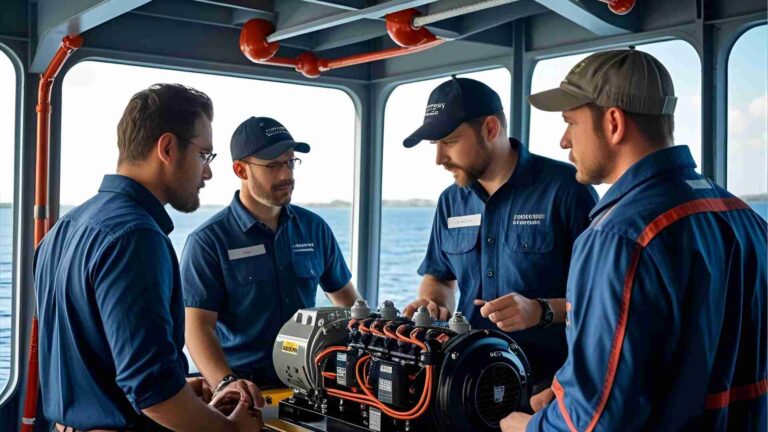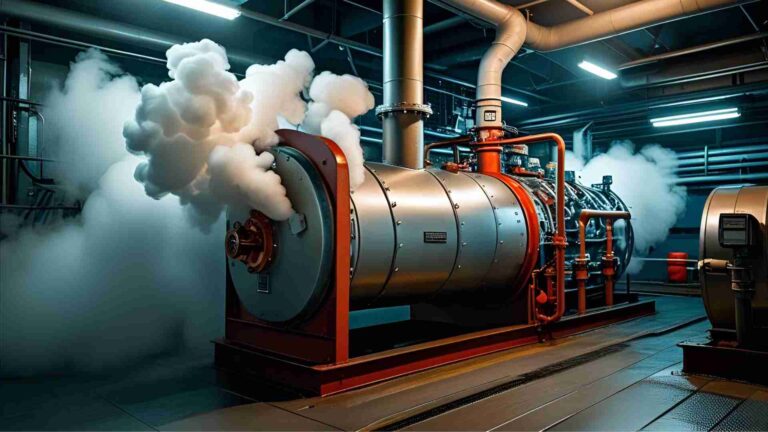Ship Buoyancy: The Science that Keeps Vessels Afloat
Introduction
Ships, from small boats to massive ocean liners, appear to defy gravity as they glide across water. Yet, the principle keeping them afloat is a fundamental law of physics known as buoyancy. Despite being made of dense materials like steel, modern ships float because of careful engineering, hull design, and the physics of displacement. Understanding buoyancy is critical not only for naval architects but also for safe maritime operations.
This article explores the science behind buoyancy, the role of density, hull design, stability, damage resilience, and practical applications. It also discusses how ships are engineered to float safely, even under heavy loads and adverse conditions.
What is Buoyancy?
Buoyancy is the upward force exerted by a fluid (liquid or gas) on an object immersed in it, opposing the object’s weight. This force allows objects, including massive ships, to float.
Archimedes’ Principle
Archimedes, the ancient Greek mathematician, discovered the principle that governs buoyancy:
“An object wholly or partially immersed in a fluid is buoyed up by a force equal to the weight of the fluid displaced by the object.”
In practical terms, for a ship to float, it must displace a volume of water whose weight equals or exceeds the ship’s weight. This explains why ships with massive steel structures remain afloat—they contain large air-filled spaces and hulls shaped to displace sufficient water.
Density and Its Role
Density is the mass per unit volume of a substance. For buoyancy:
- Water density: ~1000 kg/m³
- Steel density: ~7850 kg/m³
Ships float because their overall average density, including air-filled spaces and cargo areas, is less than water. This ensures that the total weight of the ship does not exceed the weight of water it displaces.
| Material | Density (kg/m³) |
|---|---|
| Air | 1.2 |
| Wood | 700 |
| Water | 1000 |
| Steel | 7850 |
| Lead | 11340 |
Even though steel is far denser than water, the hollow structure of ships, combined with cargo and air, creates an overall density that keeps the vessel afloat.
Hull Design: Maximizing Buoyancy
The hull is the watertight body of a ship, extending below the waterline. Its design is critical for buoyancy, stability, and hydrodynamic efficiency.
Key Factors in Hull Design
- Volume Displacement: Hulls are shaped to displace enough water to support the vessel’s weight.
- Stability: Hull shape ensures balance and resistance to capsizing.
- Hydrodynamics: Rounded and streamlined hulls reduce drag, improving speed and fuel efficiency.
Hull Types
| Hull Type | Description | Common Use |
|---|---|---|
| Displacement Hull | Pushes water aside to float | Cargo ships, tankers |
| Planing Hull | Rises on water at high speeds | Speedboats, ferries |
| Catamaran Hull | Twin hulls with wide stance | Passenger ferries, yachts |
| Semi-Displacement | Partial planing and displacement combination | High-speed ships |
Calculating Buoyancy
The buoyant force (B) acting on a ship is calculated using:
B=ρ×V×g
Where:
- ρ = density of water (~1000 kg/m³)
- V = volume of water displaced (m³)
- g = acceleration due to gravity (~9.8 m/s²)
A ship floats when buoyant force ≥ weight of the ship. Engineers use this calculation to determine hull size, cargo limits, and stability under load.
Stability in Marine Vessels
A ship may float, but if it cannot maintain balance, it risks capsizing. Stability depends on the relationship between the center of buoyancy and center of gravity.
Center of Buoyancy (B)
The center of buoyancy is the centroid of the displaced water volume. It represents the point where the upward buoyant force acts.
Center of Gravity (G)
The center of gravity is the point where the ship’s weight is concentrated. Stability requires G to be below B, creating a righting moment when the ship tilts.
Righting Moment
When a ship tilts:
- The center of buoyancy shifts toward the submerged side.
- The horizontal distance between B and G acts as a lever.
- This lever produces a restoring force that rights the ship.
Metacentric Height (GM)
GM=M−G
- M: Metacenter, the point where the buoyant force intersects the centerline when tilted
- G: Center of gravity
A larger GM indicates higher stability.

Damage Stability and Safety
Ships must remain afloat even after sustaining damage, such as flooding or hull breaches.
SOLAS Regulations
The Safety of Life at Sea (SOLAS) Convention mandates:
- Watertight Compartments: Limiting flood spread through bulkheads.
- Subdivision & Damage Calculations: Ensuring survival in worst-case damage scenarios.
- Double Hulls: Protecting against breaches and spills.
- Automatic Doors & Valves: Isolating damaged compartments quickly.
- Bilge Pumps: Removing water to maintain buoyancy.
- Stability Booklets: Providing instructions for safe operation under various load conditions.
Damage Stability in Practice
When a compartment floods:
- The ship’s center of buoyancy shifts.
- Watertight bulkheads prevent water from spreading.
- Bilge pumps and emergency systems maintain floatation until repairs.
Practical Applications of Buoyancy
Buoyancy principles are applied in:
- Cargo Ships: Maximizing load without compromising stability.
- Passenger Vessels: Ensuring safety and comfort under varying passenger loads.
- Naval Ships: Maintaining balance during high-speed maneuvers and rough seas.
- Recreational Boats: Designing small crafts for optimal floatation and stability.
The Science of Floating Ships
A ship floats because:
- It displaces water equal to its weight.
- The hull shape allows maximum water displacement with minimal material.
- Air-filled compartments lower overall density.
| Ship Example | Weight (tons) | Displaced Water (m³) | Average Density (kg/m³) |
|---|---|---|---|
| Pioneering Spirit | 900,000 | 900,000 | 1000 |
| Titanic | 52,310 | 52,310 | 1000 |
| Cruise Liner | 200,000 | 200,000 | 1000 |
Even massive vessels like the Pioneering Spirit remain buoyant due to their large displaced water volume, equal to hundreds of thousands of tons.
Why Do Massive Steel Ships Float?
- Steel alone sinks, but a hollow hull filled with air reduces density.
- The Plimsoll Line indicates safe loading to ensure sufficient displacement.
- Proper weight distribution lowers the center of gravity, enhancing stability.

Materials Used in Shipbuilding
Modern ships use:
| Material | Density (kg/m³) | Use in Ships |
|---|---|---|
| High-Strength Steel | 7850 | Hulls, structural framework |
| Aluminum Alloy | 2700 | Superstructures, lightweight vessels |
| Composites | 1600–2000 | Small crafts, specialized components |
| Reinforced Plastics | 1800–2000 | Lifeboats, small hulls |
These materials balance strength, weight, and buoyancy, enabling ships to carry heavy loads efficiently.
The Role of Air and Pressure
Air inside compartments:
- Reduces overall density.
- Maintains floatation if some compartments flood.
- Works with watertight bulkheads to prevent sinking.
Historically, ships like the Titanic highlighted the need for compartmentalization, as flooding multiple compartments led to sinking.
Buoyancy vs. Cargo Loading
Cargo weight affects water displacement:
- Empty Ship: Sits higher, displaces less water.
- Fully Loaded Ship: Sits lower, displaces more water to match weight.
The Plimsoll Line ensures ships are not overloaded, maintaining sufficient freeboard for safety.
FAQs: Ship Buoyancy
When a ship carries more weight than intended:
It sinks deeper into the water, displacing more water.
The freeboard (distance from waterline to deck) decreases, making the vessel more vulnerable to waves.
Excessive loading may exceed the buoyant force, reducing stability and increasing the risk of capsizing or sinking.
Ships are equipped with the Plimsoll Line, which indicates the maximum safe loading to maintain proper buoyancy and stability.
Steel is much denser than water, so a solid steel block would sink. However, ships are not solid steel—they are mostly hollow structures filled with air, cargo spaces, fuel tanks, and living quarters. The hollow design reduces the average density of the ship below that of water. As the ship displaces water equal to its weight, the upward buoyant force supports it, keeping it afloat.
Buoyancy is the upward force a fluid (like water or air) exerts on an object immersed in it, opposing the weight of the object. It is the reason ships, despite their massive weight, can float. This force is a direct result of water displacement; the more water a vessel displaces, the greater the buoyant force acting on it. Without buoyancy, all objects, regardless of size, would sink in water.
Watertight compartments are sections of the hull separated by bulkheads. If one compartment is breached due to damage or flooding:
Water is confined to that section.
The rest of the ship remains buoyant.
This prevents the ship from sinking immediately and gives time for emergency response.
Modern vessels often combine watertight compartments with double hulls, bilge pumps, and emergency valves to further enhance survivability.
As cargo is added:
The ship sinks slightly deeper, displacing more water.
The buoyant force increases proportionally to the displaced water.
Proper hull design and weight distribution ensure the ship does not exceed safe loading limits.
The Plimsoll Line marks maximum allowable loading to maintain safe buoyancy and stability, ensuring safe operation under different cargo weights.
Ballast tanks are compartments filled with water, sand, or other materials to adjust weight distribution:
Lower the center of gravity for stability.
Compensate for uneven cargo loads.
Help ships adjust trim when fuel is consumed or cargo is unloaded.
Submarines use ballast tanks to control diving and surfacing, applying the same buoyancy principle.
Steel, aluminum alloys, composites, and reinforced plastics balance strength and weight to enhance buoyancy.
Conclusion
Ship buoyancy is the foundation of naval engineering. Understanding Archimedes’ principle, hull design, density, and stability allows engineers to design vessels that float safely, carry massive loads, and withstand the challenges of the open ocean.
From steel cargo ships to luxurious cruise liners, every floating marvel relies on balance, displacement, and careful weight management. Modern technologies, watertight bulkheads, and computerized monitoring systems enhance safety and buoyancy control, ensuring ships remain afloat even in adverse conditions.
Buoyancy is more than physics; it is a maritime art and engineering achievement, enabling humans to navigate the seas with safety, efficiency, and confidence.
Happy Boating!
Share Ship Buoyancy: The Science that Keeps Vessels Afloat with your friends and leave a comment below with your thoughts.
Read MARPOL Annex VI: Refrigerants in Marine Systems On Ships until we meet in the next article.






